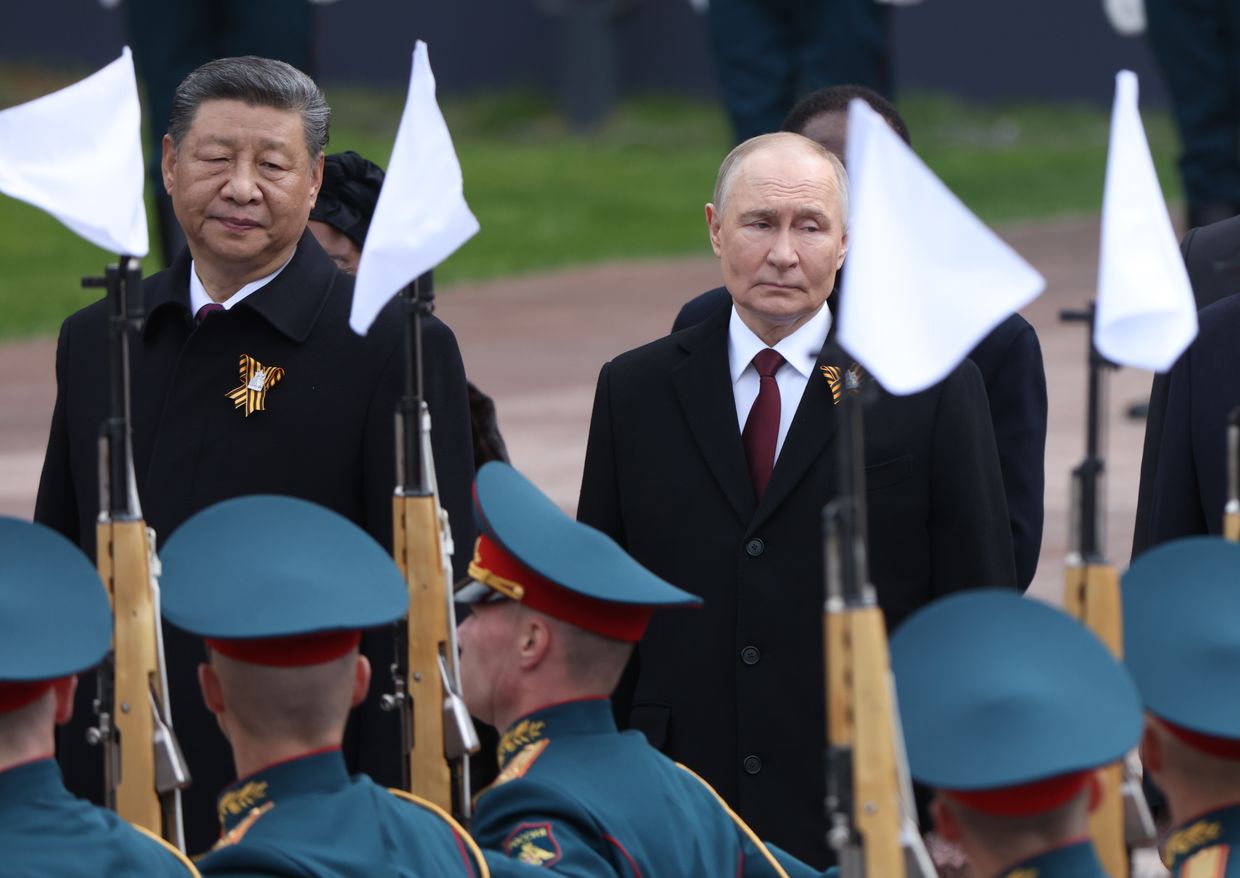Taiwan Votes in Recall Campaign That Tests China’s Nerves

© I-Hwa Cheng/Agence France-Presse — Getty Images

© I-Hwa Cheng/Agence France-Presse — Getty Images

Beijing continues fueling Russia’s war against Ukraine. Chinese companies are supplying engines for attack drones through front companies, falsely labeling them as “industrial refrigeration units” to bypass Western sanctions, Reuters reports.
According to the report, Russian arms producer IEMZ Kupol signed a contract with Russia’s Ministry of Defense to manufacture over 6,000 Garpia-A1 drones in 2025, which is three times more than the previous year.
By April, over 1,500 drones had already been assembled and were being launched en masse against Ukrainian military and civilian targets, up to 500 per month, according to Ukraine’s military intelligence.
A key component of the Garpia drone is the Chinese L550E engine produced by Xiamen Limbach Aviation Engine Co. After sanctions were imposed on Xiamen, a new Chinese firm, Beijing Xichao International Technology and Trade, began delivering the same engines to Russia.
In shipping documents, they were labeled as cooling units, enabling unimpeded transfer in violation of sanctions.
The UN Human Rights Monitoring Mission in Ukraine documented 232 civilian deaths and 1,343 injuries in June 2025, marking the highest monthly casualty toll in three years as Russian forces launched ten times more missile strikes and drone attacks than in June 2024.
The supply route ran through a network of shell companies: from Beijing to Moscow, and then to Izhevsk, where the Kupol plant is located. According to sources in three EU intelligence services, the shipments first went to a firm called SMP-138, then to another company, LIBSS, which delivered the engines directly to the factory. This is how “refrigerators” became weapons.
Despite repeated warnings, Chinese airlines, including Sichuan Airlines and China Southern Airlines, continued transporting drone components since at least October 2024.
Previously, US Army Europe and NATO Allied Forces Supreme Commander General Alexus Grynkewich warned that American and its European allies likely have only a year and a half to prepare for a potential global military conflict with China and Russia. The dictatorships may launch a coordinated strike in 2027.


© Kenny Holston/The New York Times

© Gilles Sabrié for The New York Times

© Jessica Lee/EPA, via Shutterstock

© Tingshu Wang/Reuters

A new Russian drone built to deceive Ukrainian air defenses has been exposed by Ukraine’s intelligence as being made entirely from Chinese components. Militarnyi reports that the aircraft, though intended primarily as a decoy, is capable of carrying a 15-kg warhead.
Ukraine’s Main Intelligence Directorate has published a detailed breakdown of the drone’s construction. Although its main function is to act as a false target alongside long-range drones, it can also carry a warhead weighing up to 15 kg.
The complete list of components has been published on the War&Sanctions portal. The Website identify the drone as TsBST.611000.
All onboard systems and electronic blocks are of Chinese origin. Nearly half of them — including the flight controller with autopilot, navigation modules and antennas, airspeed sensor, and Pitot tube — come from a single Chinese company, CUAV Technology. The company specializes in developing and producing UAV system modules and applications.
The UAV is also equipped with a Chinese-made copy of the Australian RFD900x data transmission module by RFDesign. Like the original, this device is designed to transmit data over long distances — up to 40 km in line of sight depending on the antenna. It enables data links from the drone to a ground station or from one UAV to another, expanding reconnaissance capabilities.
In October 2022, CUAV Technology announced restrictions on supplying its products to both Ukraine and Russia to prevent their use in military applications. However, in 2023, Russia presented a vertical takeoff drone as an original development, which turned out to be a CUAV product available on Aliexpress.

© Saul Loeb/Agence France-Presse — Getty Images

© Saul Loeb/Agence France-Presse — Getty Images

© Vincent Thian/Associated Press

© Vincent Thian/Associated Press

Beijing threatens to respond following sanctions for cooperation with Russia. The European Union has, for the first time, included Chinese banks and companies in a new sanctions package against Russia for the attack on Ukraine.
On 4 July, Chinese Foreign Minister Wang Yi told the EU’s foreign affairs chief Kaja Kallas that Beijing, Moscow’s top economic ally, cannot allow Russia to lose in its war against Ukraine. China fears that such an outcome would allow the US to fully pivot its attention to Beijing, he said.
Beijing’s reaction was immediate and harsh: “China expresses strong dissatisfaction and resolute protest.”
According to a statement from the Ministry of Commerce of the People’s Republic of China, the Chinese side views the 18th sanctions package as an unfriendly act that violates international law, undermines economic relations with the EU, and threatens financial cooperation.
Four Chinese companies were added to the EU blacklist, including two from Hong Kong, Zhu Jiang Shipmanagement and ACE Electronic HK, as well as Wuhan Global Sensor Technology and Shandong ODES Industry from mainland China. The reason: assistance to Russia in circumventing restrictions, supplying technologies and components that can be used in the production of weapons that kill Ukrainians.
“China calls on the EU to immediately stop its wrongful practice of including Chinese enterprises and financial institutions on sanction lists and will take necessary measures to reliably protect the lawful rights and interests of Chinese companies,” the statement said.
China’s outrage coincides with preparations for the 25th anniversary China–EU summit, scheduled for 24 July in Beijing. This is the second consecutive time the summit will not be held in Europe as Xi Jinping refused to travel to Brussels, and instead, European leaders will come to China to discuss the most sensitive issues in bilateral relations.
Despite the pressure, Brussels sends a clear signal: sanctions evasion via third countries, including China, will no longer go unanswered.
Previously, US Army Europe and NATO Allied Forces Supreme Commander General Alexus Grynkewich has warned that American and its European allies likely have only a year and a half to prepare for a potential global military conflict with China and Russia. According to Bild, the two dictatorships may launch a coordinated strike in 2027.

© Mahesh Kumar A./Associated Press

© Gilles Sabrié for The New York Times

© Gabby Jones for The New York Times

© Vernon Yuen/Associated Press
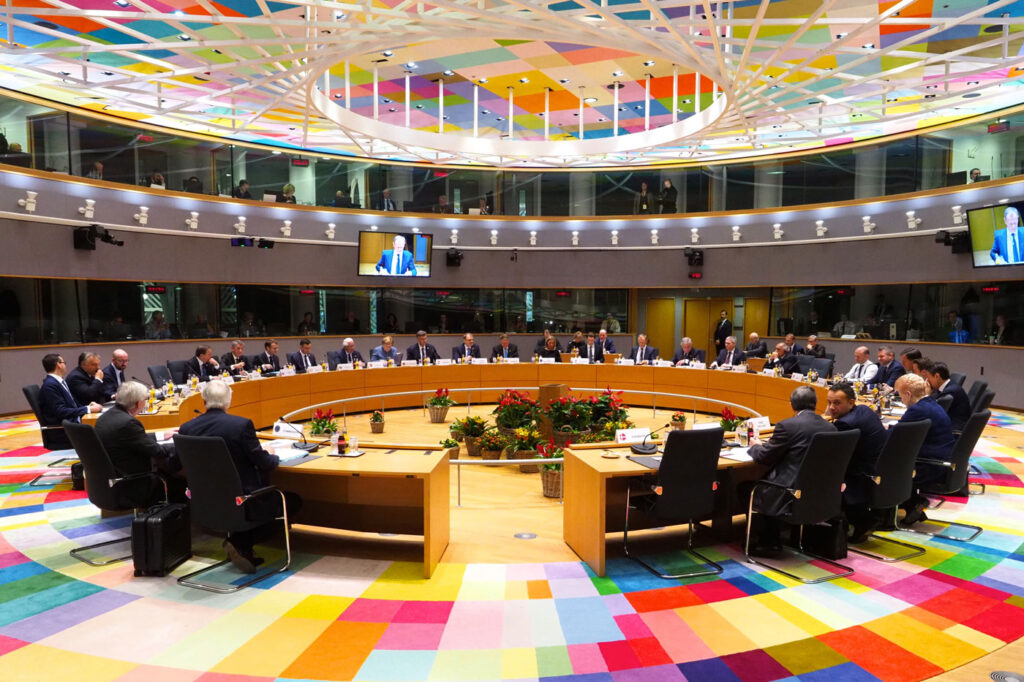
As the EU ramps up economic pressure, the Kremlin scrambles to downplay sanctions by pushing claims of immunity and resilience. But behind the bravado, top Russian officials are quietly conceding the growing toll on the country’s economy, according to the think tank Institute for the Study of War (ISW).
ISW reported on 18 July that Russian officials are continuing to falsely claim that the European Union’s newest sanctions have no significant impact on the Russian economy. Kremlin Spokesperson Dmitry Peskov alleged for no reason that the EU’s sanctions are illegal, and insisted Russia had already adapted to life under restrictive measures. He stated that the Kremlin would analyze the effects of the latest sanctions package and minimize their impact. Peskov also stated that the sanctions ostensibly ultimately harm those who imposed them.
Russian Security Council Deputy Chairperson Dmitry Medvedev responded to the EU’s newest package by asserting that Russia’s stance remains unchanged and that the country’s economy will endure. He went further, threatening to increase strikes on Kyiv and other Ukrainian cities — which has already been happening for years. Medvedev declared that Russia must learn to “hate” the EU and what he described as its “Russophobia” as much as its ancestors did.
Kirill Dmitriev, CEO of the Russian Direct Investment Fund (RDIF) and Putin’s Special Representative for Investment and Economic Cooperation with Foreign Countries, echoed similar showy defiance. He claimed that the sanctions hurt Europe more than Russia by closing Russian markets to European businesses and disrupting the continent’s energy supply. Meanwhile, Head of the Russian State Duma Committee on Financial Markets Anatoly Aksakov dismissed the new financial sanctions as insignificant, calling them “just a fluctuation in the air,” since Russian banks were already operating under EU restrictions.
Despite these bold public statements, ISW highlighted that some senior Russian officials are now quietly admitting that sanctions are taking a toll on the economy. The Moscow Times reported on 17 July that Russian Energy Minister Sergei Tsivilev recently told the Russian Federation Council that Western sanctions are making it difficult for Russian oil companies to obtain parts needed to repair refineries.
Russian Central Bank Chairperson Elvira Nabiullina openly stated on 19 June that Russia has “exhausted many of its free resources” since the start of the full-scale invasion and must now search for a new growth model. Minister of Economic Development Maxim Reshetnikov also acknowledged during SPIEF that the Russian economy stands “on the brink of recession.”
ISW underscored that sanctions evasion through the People’s Republic of China and other third-party networks is now a key pillar of Moscow’s strategy. The Kremlin has built a network of actors designed to bypass Western restrictions, and has started reconfiguring its economic policies and business models to survive sanctions in the long run. However, ISW wrote, hinting on Washington’s hesitation to adopt news sanctions against Russia:
“The EU’s newest sanctions are a positive step, but wider Western compliance and enforcement are necessary to inflict maximum economic pressure on Russia.“
The EU’s 18th sanctions package, approved on 18 July by the European Council, sharply undercuts Russian oil revenues. It slashes the oil price cap to $47.60 per barrel, bans Nord Stream pipeline transactions, and blacklists 105 more shadow fleet tankers—bringing the total to 444. It also targets entities tied to Rosneft and ends Czechia’s exemption for Russian oil.
Refined products from Russian crude are banned unless processed in select Western countries. Though the Kremlin budgeted for losses, these sanctions are expected to cut far deeper—threatening the third of federal revenue tied to oil.

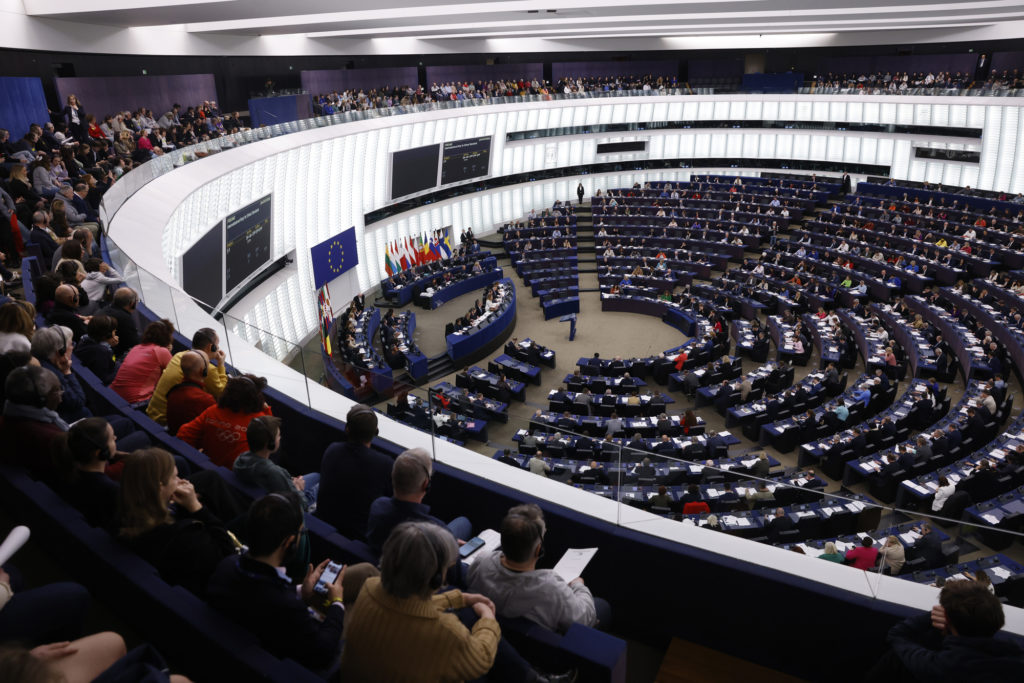
The EU may revisit the vote on its 18th sanctions package against Russia as early as 18 July after the bloc’s representatives failed to reach a consensus on Wednesday, 16 July. The deadlock stems from Slovakia’s opposition, which is tied to the European Commission’s gas policy.
According to The Guardian, Slovakia is demanding guarantees on Russian gas supplies and wants changes to the European Commission’s plan to phase out all Russian gas imports by 2028. Slovak Prime Minister Robert Fico has said he aims to reach a compromise with the EU by 15 July.
“No green light today on Russian sanctions during debate with
ambassadors. They may return to the issue on Friday,” reports Rikard Jozwiak from Radio Free Europe/Radio Liberty.
The proposed sanctions package reportedly includes:
A “dynamic mechanism” for pricing Russian oil, 15% below the market price, which is approximately $47 per barrel
Meanwhile, Estonia has warned it will block the package if the provision to lower the oil price cap is removed, ERR writes.
“We have a very clear position that the oil price cap reduction must be included in this package. We hold a very firm stance on this issue,” Estonian Foreign Minister Margus Tsahkna says.
At the same time, Lithuanian Foreign Minister Kęstutis Budrys has expressed hope that pressure on Russia will only intensify, according to Delfi. He has also announced that the country will begin its work on the next 19th sanction package after the 18th is adopted.
“The next package should follow, and we will continue this process until the Russian war machine either chokes or shuts down due to lack of revenue,” he has noted.
Unanimity remains the EU’s only path to advancing sanctions policy, and Russia has proven adept at exploiting this vulnerability.

© May James/Agence France-Presse — Getty Images

© Carlos Osorio/Reuters

© Andrea Verdelli for The New York Times

© Lukas Coch/AAP, via Reuters

© Pedro Pardo/Agence France-Presse — Getty Images

© Norbert Barczyk/PressFocus, via MB Media, via Getty Images

© Kevin Frayer/Getty Images

© Haiyun Jiang/The New York Times

© Haiyun Jiang/The New York Times
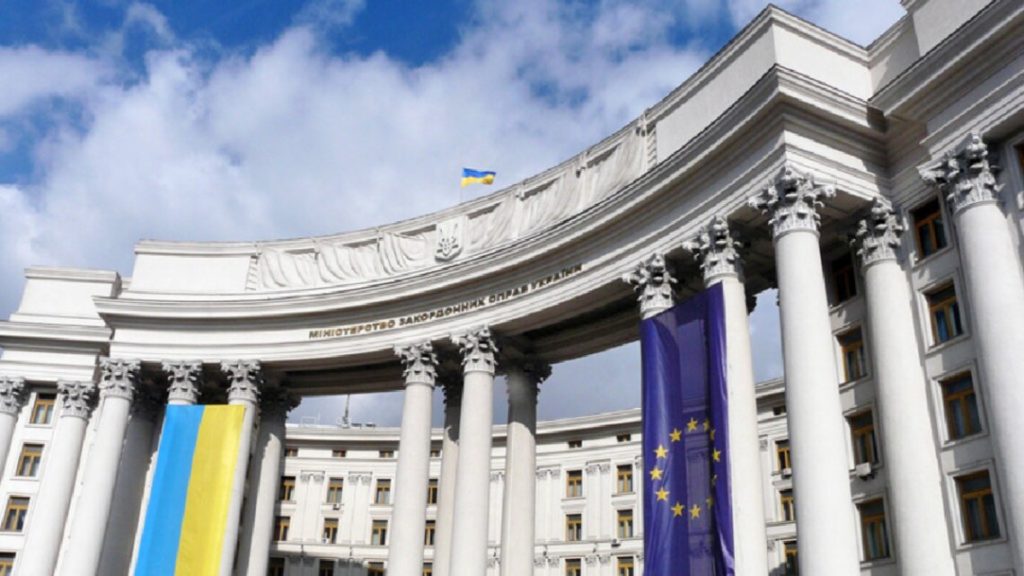
Stability in Ukraine is in China’s own interest, and Beijing holds the most powerful levers to influence Moscow and urge Russian ruler Vladimir Putin to end the war, Ukrainian Foreign Ministry spokesperson Heorhii Tykhyi says, according to UkrInform.
In July 2025, European Commission President Ursula von der Leyen warned that the future of the EU’s policy toward China would rely on Beijing’s involvement in supporting Russia’s war efforts. Moscow is dependent on supplies of Chinese components for both tactical and long-range drones. This allows Moscow to narrow the technological and production gap with Ukraine in the drone sector. The cooperation poses a threat to the European Union, said von der Leyen.
Tykhyi calls on China, which has been called the main sponsor of Russia’s war, to view Ukraine not merely as another European country, but as a future member of the European Union. He emphasizes that “Ukraine–China relations are ongoing, dialogue exists.” Kyiv is also openly responding to instances of Chinese citizens participating in combat on Russia’s side or engaging in acts of industrial espionage.
For instance, on 9 July, Kyiv detained two Chinese nationals, accused of attempting to steal classified documentation on Ukraine’s Neptune anti-ship missile system. The weapon that sank Russia’s flagship Moskva.
The younger suspect studied at a Kyiv technical university until 2023, when he was expelled for poor grades. Instead of returning to China, he stayed in Ukraine. The SBU suggests he used his remaining contacts to target someone with access to advanced weapons development.
“Recently, Chinese nationals were detained for gathering sensitive information about Ukrainian weapons. These facts are not being concealed,” the spokesperson says, adding that such incidents damage bilateral relations, and Ukraine cannot ignore threats amid all-out war.
Earlier, Chinese Foreign Minister Wang Yi told a senior EU diplomat that China “cannot accept” Russia’s defeat in the war against Ukraine, arguing that such an outcome would allow the US to focus its foreign policy on Beijing. However, this does not fully indicate that Beijing is focused on Moscow’s victory.

© Pool photo by Mandel Ngan

© Pool photo by Mandel Ngan

© Peter Parks/Agence France-Presse — Getty Images

© The New York Times

© Doug Mills/The New York Times

© Doug Mills/The New York Times
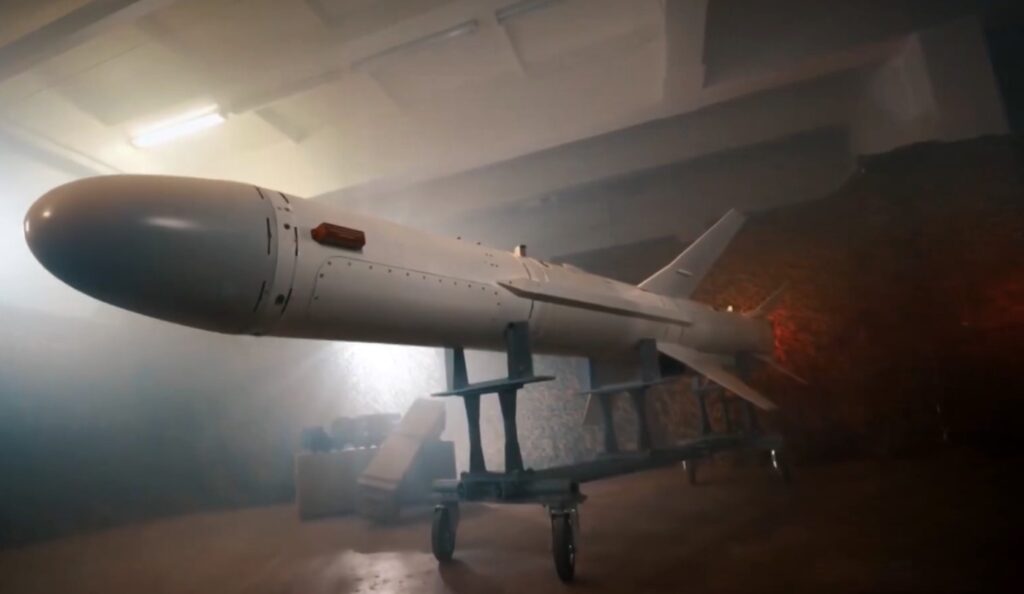
Two Chinese nationals sit in Ukrainian custody tonight, accused of attempting to steal classified documentation on Ukraine’s Neptune anti-ship missile system. The weapon that sank Russia’s flagship Moskva.
The Security Service of Ukraine (SBU) says it caught the pair red-handed in Kyiv. A 24-year-old former university student and his father, who resides in China but made periodic visits to Ukraine.
The younger suspect studied at a Kyiv technical university until 2023, when he was expelled for poor grades. Instead of returning to China, he stayed in Ukraine. The SBU suggests he used his remaining contacts to target someone with access to advanced weapons development.
His father allegedly traveled to Ukraine to personally coordinate intelligence operations, according to the security service’s investigation. The family business, apparently, was espionage.
The student attempted to recruit a Ukrainian citizen connected to cutting-edge defense projects. The goal: technical documentation on Neptune missile production that could be smuggled back to Chinese intelligence services.
Ukrainian counterintelligence officers say they identified the operation early and arrested the student during a document handover. His father was detained as he prepared to transfer the stolen information to Beijing.
During searches, investigators seized mobile phones containing what they describe as coordination messages between the two suspects.
Both face espionage charges under Ukraine’s Criminal Code. Maximum sentence: 15 years with property confiscation.
The weapon has proven its worth in combat. Two Neptune missiles sank the Russian cruiser Moskva in April 2022—the Black Sea Fleet’s flagship and a potent symbol of Russian naval power. In March 2024, another Neptune strike hit the landing ship Konstantin Olshansky at its occupied Crimean base, rendering the vessel incapable of combat.
The missile itself measures just over five meters long and weighs 870 kilograms (1 918 lbs). Range: up to 280 kilometers (173 miles). It can sink vessels displacing up to 5,000 tons.
Recent modifications expanded the Neptune’s capabilities beyond ships to ground targets that has an extended range of up to 1,000 kilometers (621 miles).
This advancement allows Ukraine to strike deep into Russian territory, including strategic targets such as oil refineries, exemplified by a likely 14 March strike on a refinery in Tuapse about 450 km (279 miles) from the front line.
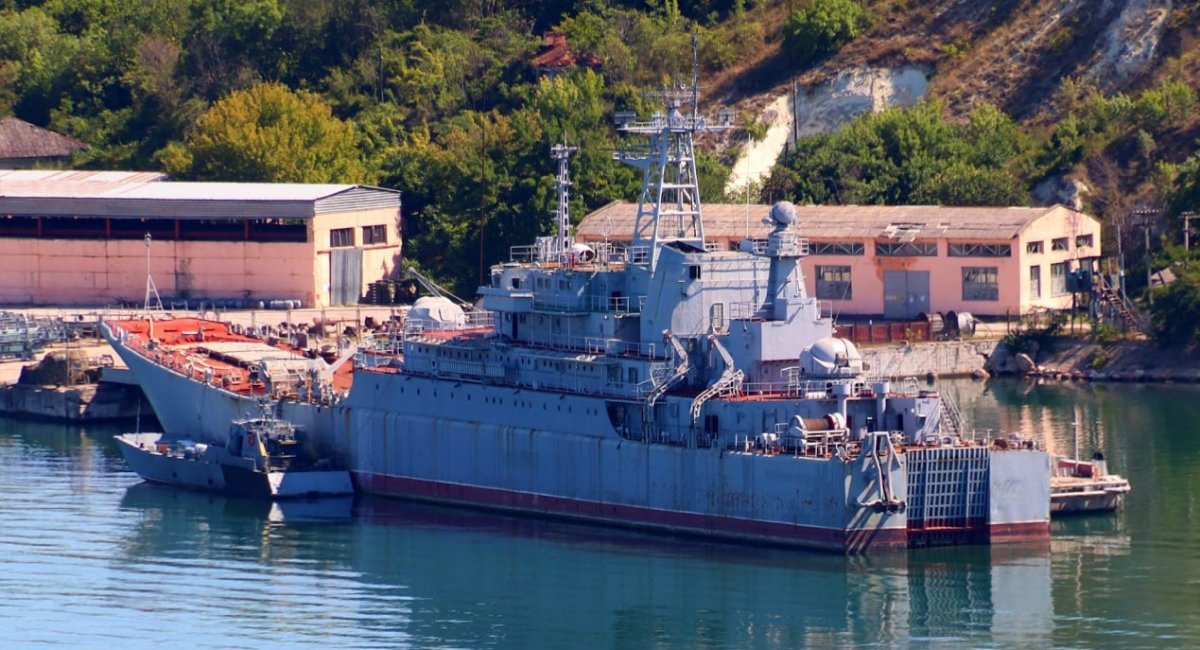

Ukrainian drones seized a Russian fortified position and captured prisoners-of-war in Kharkiv Oblast. The 3rd Assault Brigade calls it the first battlefield capitulation to robotic platforms. Ukrainian infantry didn’t engage in combat. They entered only after Russian forces surrendered, and the treeline was clear.
On 9 July, Ukraine’s 3rd Separate Assault Brigade announced that its drone and ground robot operators forced Russian troops to surrender in Kharkiv Oblast — without any infantry engagement or Ukrainian losses.
According to the Brigade, the robotic strike involved both an FPV drone and a kamikaze ground drone carrying three antitank mines — a total of 21-22.5 kg of TNT. The FPV and the first ground drone’s blast hit a dugout entrance in the Russian position. As another land robot moved in for a second strike, two surviving Russian soldiers waved a cardboard sign reading “We want to surrender” in Russian.
“The explosion with the three antitank mines — that was a very powerful blast. The dugout wasn’t fully destroyed, so we got the order to hit it again. We moved in, and they realized we were going to blow it up again. […] ..and they very quickly put the sign out,” one of the Ukrainian soldiers said.
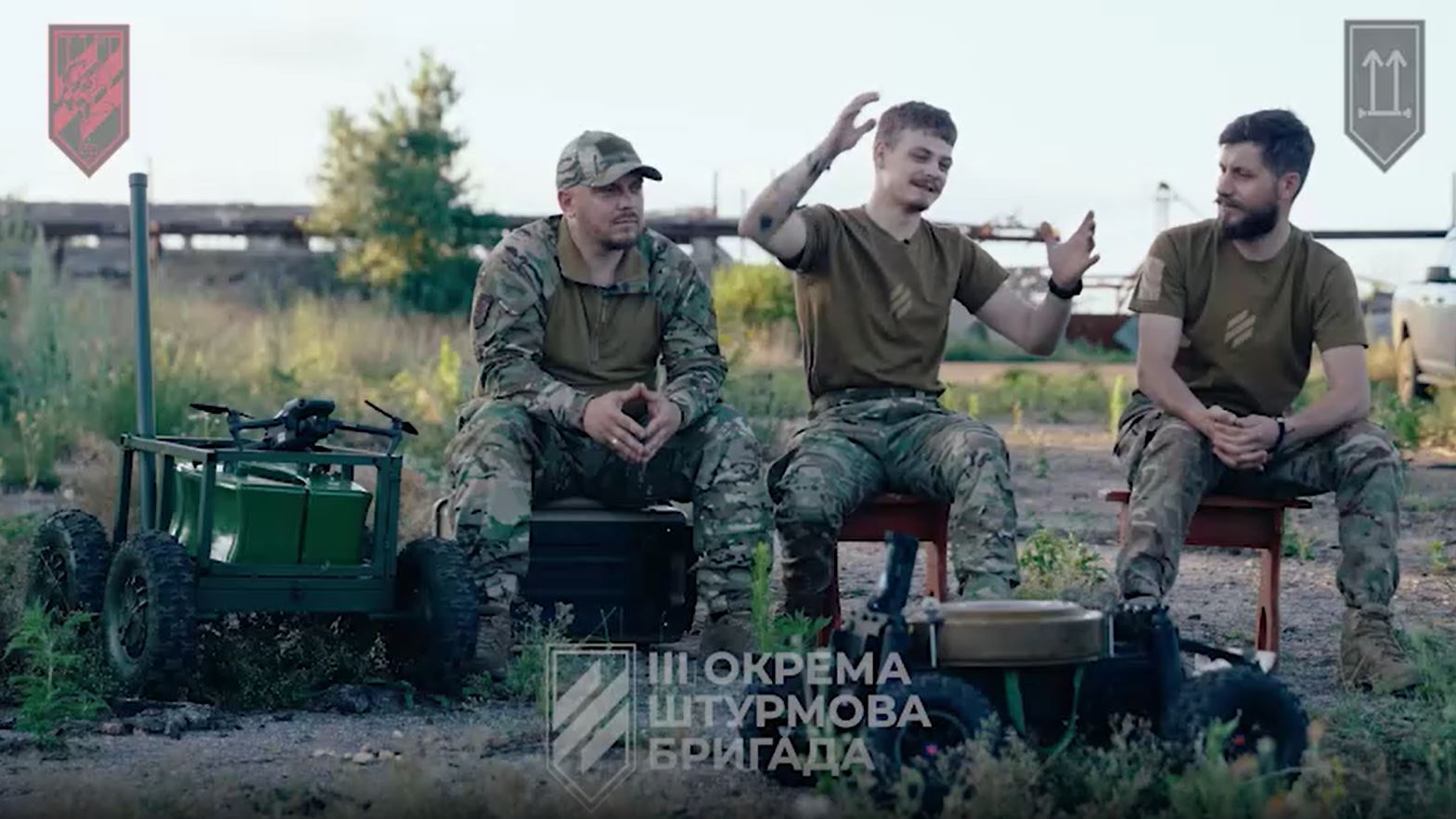
The 3rd Assault Brigade’s Telegram post includes a video file timestamped 8 July, featuring aerial footage of the engagement and the enemy’s surrender. Additionally, Ukrainian drone operators narrate the footage and recount the operation. However, the exact date of the robotic engagement itself is not explicitly stated.

The video shows an aerial FPV drone strike, a powerful explosion of an “NRK”—a remotely controlled “ground robotic complex”—at the entrance to the dugout, and the Russian soldiers displaying the sign.
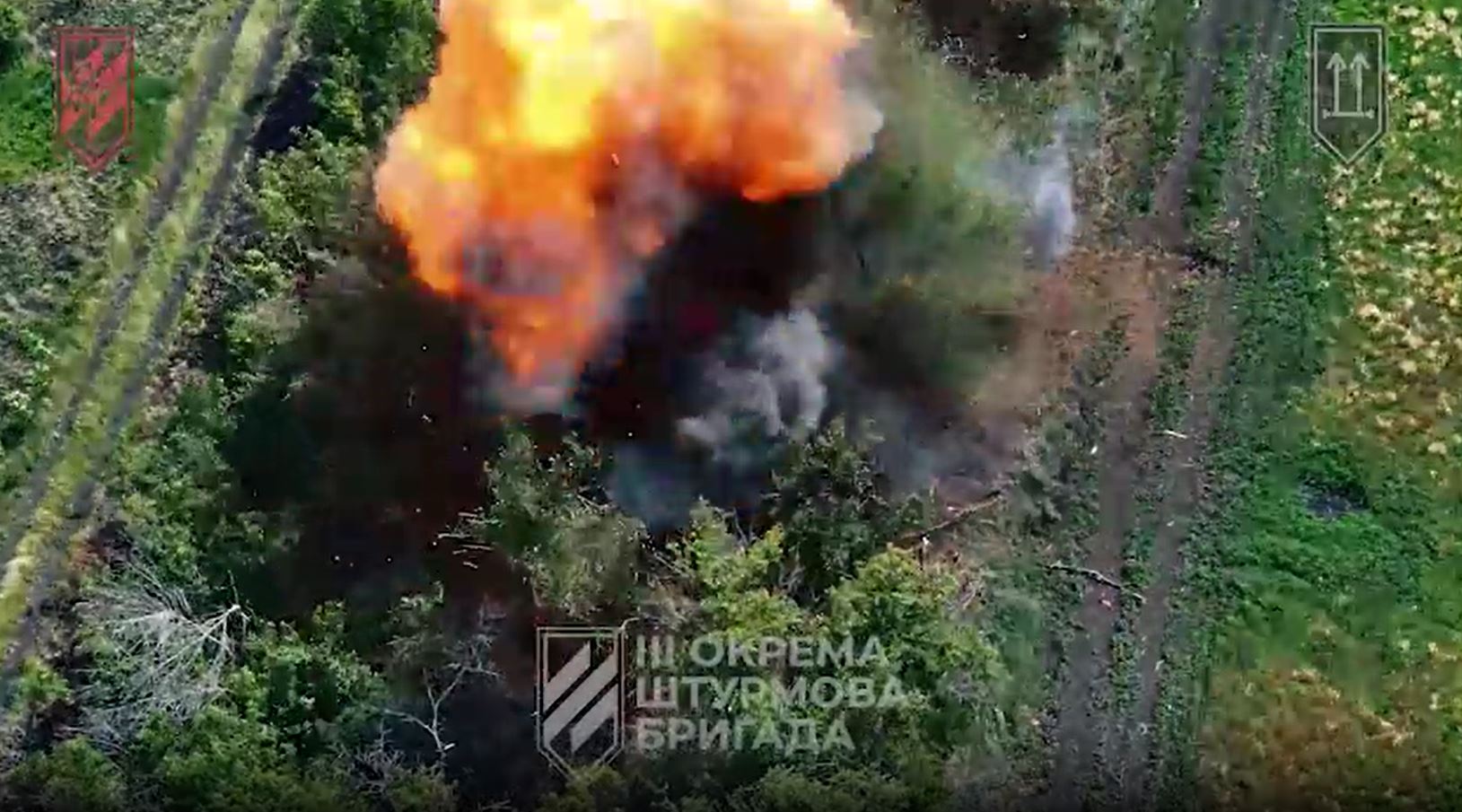
As recounted by the NC13 unit of the DEUS EX MACHINA drone company, a small reconnaissance UAV was used to guide the surrendering soldiers safely to Ukrainian lines.
“Then the major flew down the Mavic (a Chinese drone, widely used for reconnaissance by both sides, – Ed.), we showed them with the drone — like, come here. [..] They followed the Mavic precisely and lay down in the ‘dolphin pose’ on the ground,” the military said.
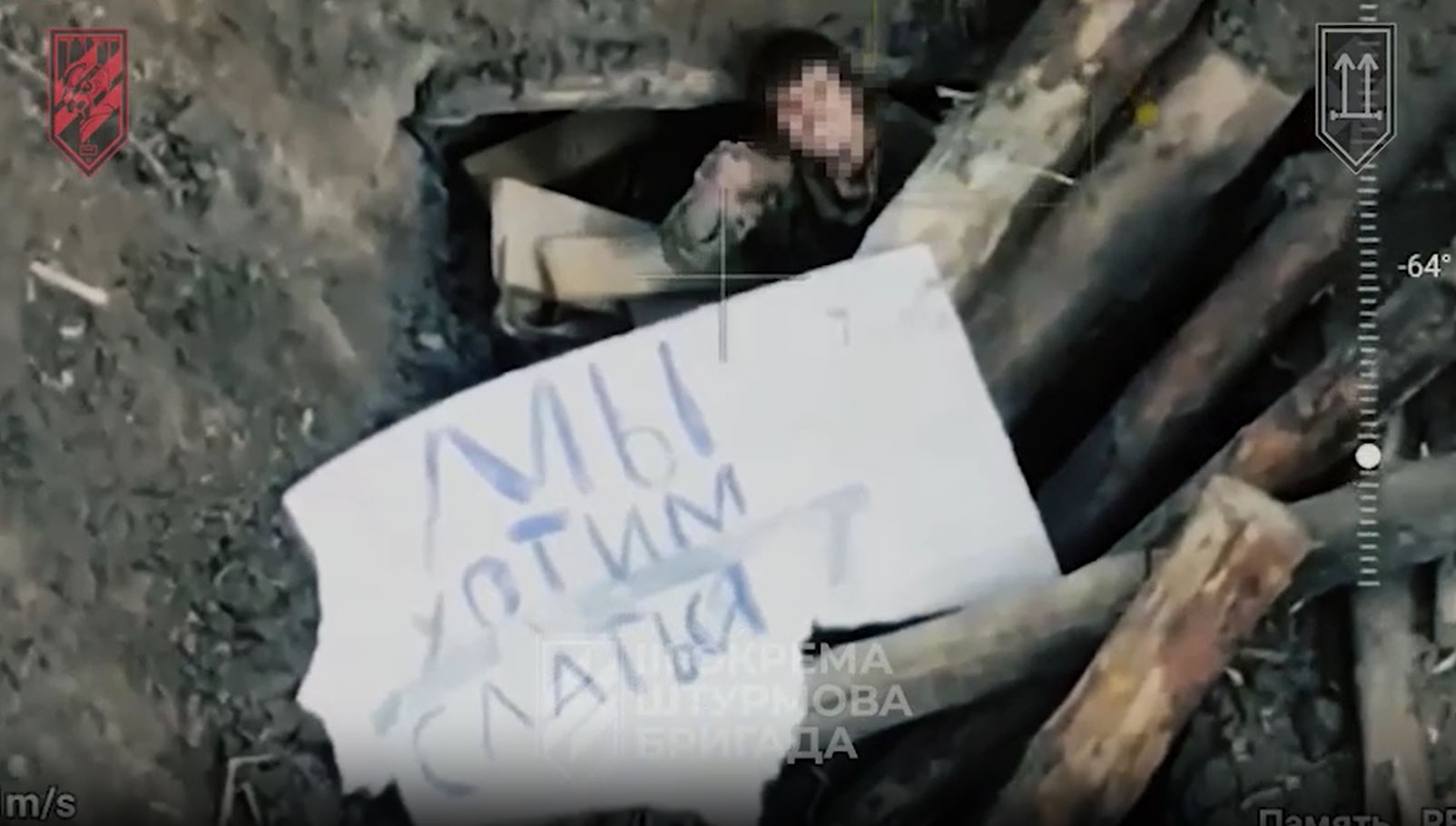
After the Russian surrender, Ukrainian infantry moved in quickly and secured the position. The brigade noted that previous Ukrainian attempts to storm the area had failed. This time, however, the assault team held back while drones led the operation.

Once the Russian troops were taken prisoner, the planned infantry clearing operation began — but was largely symbolic. The drone operator noted in the interview:
“A clearing operation was planned there — we were supposed to carry out the strike, and they were supposed to clear the area. But it turned out that… that unit took over the dugout’s treeline in just 15 minutes. The entire strip was already ours — literally, and without any losses. You could say, not a single shot was fired.”
He said the drone-led engagement proved that robotic platforms “make operations significantly easier.” In some cases, they “even free the infantry from the task entirely.”
“Our example proved that with robotic platforms, it’s possible not only to storm positions but also to take prisoners,” another drone operator emphasized.

© Doug Mills/The New York Times

© Doug Mills/The New York Times

© Loren Elliott for The New York Times
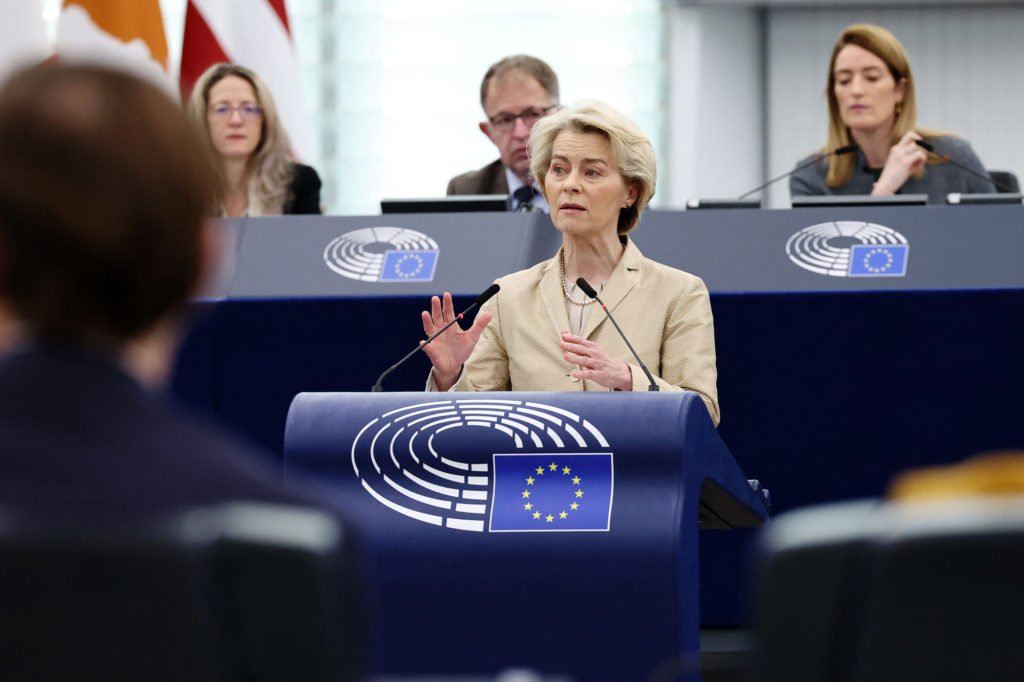
European Commission President Ursula von der Leyen has warned that the future of the EU’s policy toward China will depend on Beijing’s involvement in supporting Russia’s war economy, UkrInform reports.
Her statement comes after Chinese Foreign Minister Wang Yi told a senior EU diplomat that China “cannot accept” Russia’s defeat in the war against Ukraine, arguing that such an outcome would allow the US to focus its foreign policy on Beijing.
Von der Leyen has stressed that China’s support for Moscow is contributing to a “high level of instability and danger for Europe,” and that Beijing is de facto enabling the growth of Russia’s military-industrial base, a trend the EU “cannot accept.”
She also called on China to clearly condemn Russia’s violation of Ukraine’s sovereignty, territorial integrity, and internationally recognized borders, and to act accordingly.
Meanwhile, Ukrainian President Volodymyr Zelenskyy has imposed sanctions on five Chinese companies involved in supplying components used in Russian drone production.
The restrictions have been approved after investigations revealed that Chinese-made parts were found in Shahed drones used in the massive airstrike on Kyiv on 4 July.
Among the sanctioned firms are:
Both reportedly supplied goods to Russian entities under sanctions in 2024 and 2025.
Russia is heavily dependent on supplies of Chinese components for both tactical and long-range drones. This allows Moscow to narrow the technological and production gap with Ukraine in the drone sector.
Earlier, Ukraine’s Defense Intelligence had identified dozens of Russian companies involved in producing the missile, most of which remain unsanctioned.
HUR: West still has not sanctioned 70 Russian companies behind production of missiles that struck Kyiv’s largest children’s cancer hospital year ago
Its War & Sanctions platform has published a list of over 70 Russian companies manufacturing Kh-101 components. These companies still have access to Western equipment and technology, enabling Russia to replenish its missile stockpiles and continue targeting civilian infrastructure.

Chinese drone parts in Russian weapons are helping Russia expand its drone war in Ukraine, Bloomberg reports. Documents reviewed by Bloomberg show Russian firm Aero-HIT partnered with Chinese suppliers and engineers to mass-produce combat drones now used across the frontline.
In early 2023, Aero-HIT began working with engineers from Autel Robotics, China’s major manufacturers of drones and drone parts, to adapt the civilian Autel EVO Max 4T for military use, according to Bloomberg. The model proved effective in combat and resistant to jamming.
Aero-HIT claims it can produce up to 10,000 drones per month at its Khabarovsk facility. Its Veles FPV drone has been deployed in Kherson and elsewhere. A March 2024 order priced the units at $1,000 each.
Despite sanctions, Chinese drone parts in Russian weapons continue reaching Russia through intermediaries. Bloomberg identified firms like Renovatsio-Invest and Shenzhen Huasheng Industry—both under US sanctions—as key suppliers. Civilian companies in sectors like seafood and catering were used to obscure transactions.
Autel says it cut ties with Russia in February 2022. Yet, documents show resumed contact with its engineers by late 2024 and production plans ongoing into 2025.
The partnership began in late 2022, Bloomberg says. Russian company Komax, linked to sanctioned senator and ex-KGB officer Konstantin Basyuk, led talks with China’s Harbin Comprehensive Bonded Zone. In May 2023, a Russian delegation visited Autel and the Harbin Institute of Technology.
After the visit, Aero-HIT was registered, production began soon after. In August 2024, the Defense Ministry requested 5,000 Veles drones.
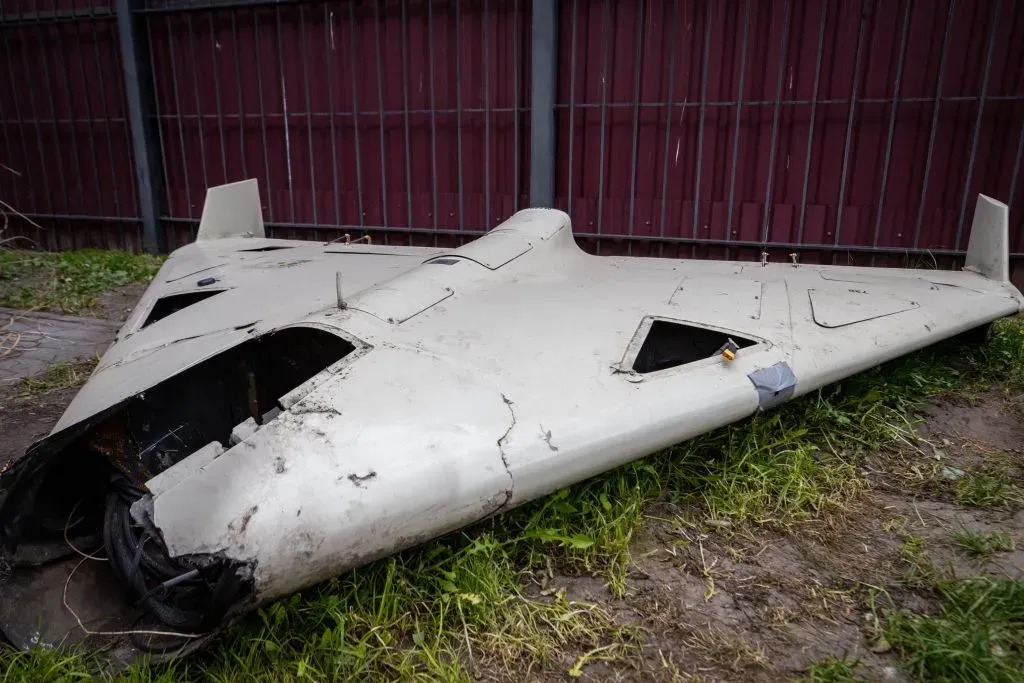
President Volodymyr Zelensky signed an order on July 8 imposing sanctions on five Chinese-registered companies accused of supplying components found in Russian Shahed-type drones used to attack Ukraine.
The decree follows a statement by Ukraine's Security Service (SBU), which said it recovered Chinese-made parts from downed drones during a July 4 air assault on Kyiv.
Sanctions were imposed on Central Asia Silk Road International Trade, Suzhou Ecod Precision Manufacturing, Shenzhen Royo Technology, Shenzhen Jinduobang Technology, and Ningbo BLIN Machinery.
The list was published on the Presidential Office's website alongside the official decision by Ukraine's National Security and Defense Council.
Russia's domestically produced drones based on Iran's Shahed-136 is a loitering munition extensively used by Russia to target Ukrainian cities, and is assembled with components sourced from around the world. Kyiv has warned that some of these parts continue to flow through countries that have not joined Western sanctions.
China has emerged as one of Moscow's key wartime partners, helping Russia circumvent sanctions and becoming the largest supplier of dual-use goods aiding its defense sector.
Vladyslav Vlasiuk, the Ukrainian president's commissioner for sanctions, told journalists on July 7 that Russia's growing ability to sustain weapons production is being driven by a flow of Chinese components and materials.
Zelensky has repeatedly accused China of backing Russia and providing technological and logistical support for its war effort. On May 29, he said Beijing had blocked the sale of drones to Ukraine while continuing to supply them to Russia.
Ukraine has already sanctioned several Chinese companies tied to Russia's war effort.
As Russian-Chinese relations deepen, Russian President Vladimir Putin is expected to visit China in September, where he is scheduled to meet with Chinese leader Xi Jinping.
 The Kyiv IndependentTim Zadorozhnyy
The Kyiv IndependentTim Zadorozhnyy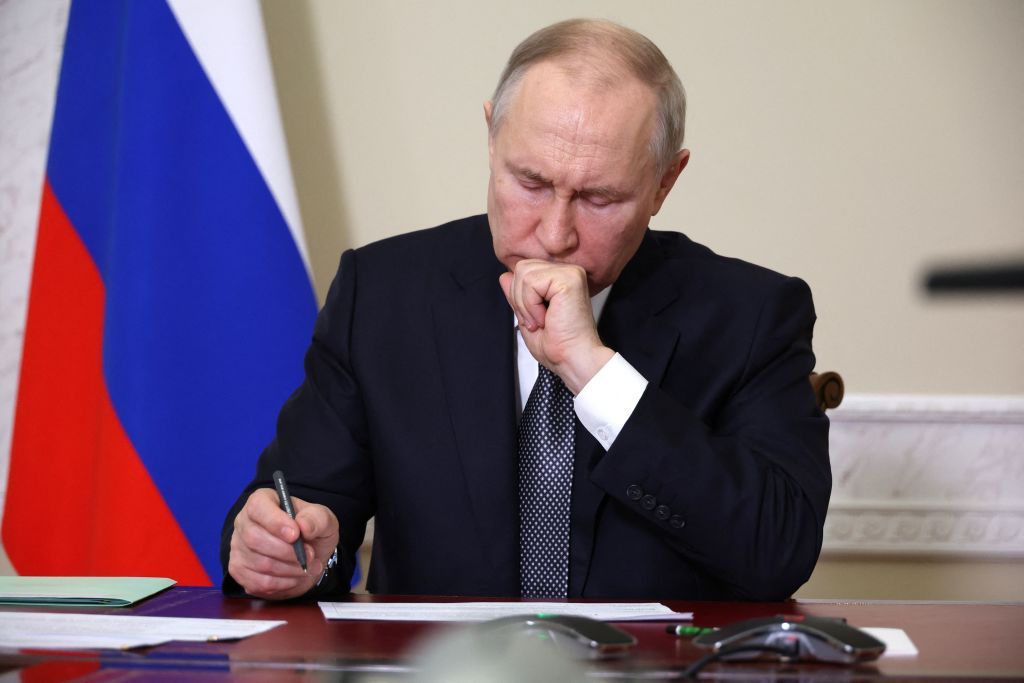

© César Rodríguez for The New York Times

© Dmitry Kostyukov for The New York Times

© Pablo Porciuncula/Agence France-Presse — Getty Images
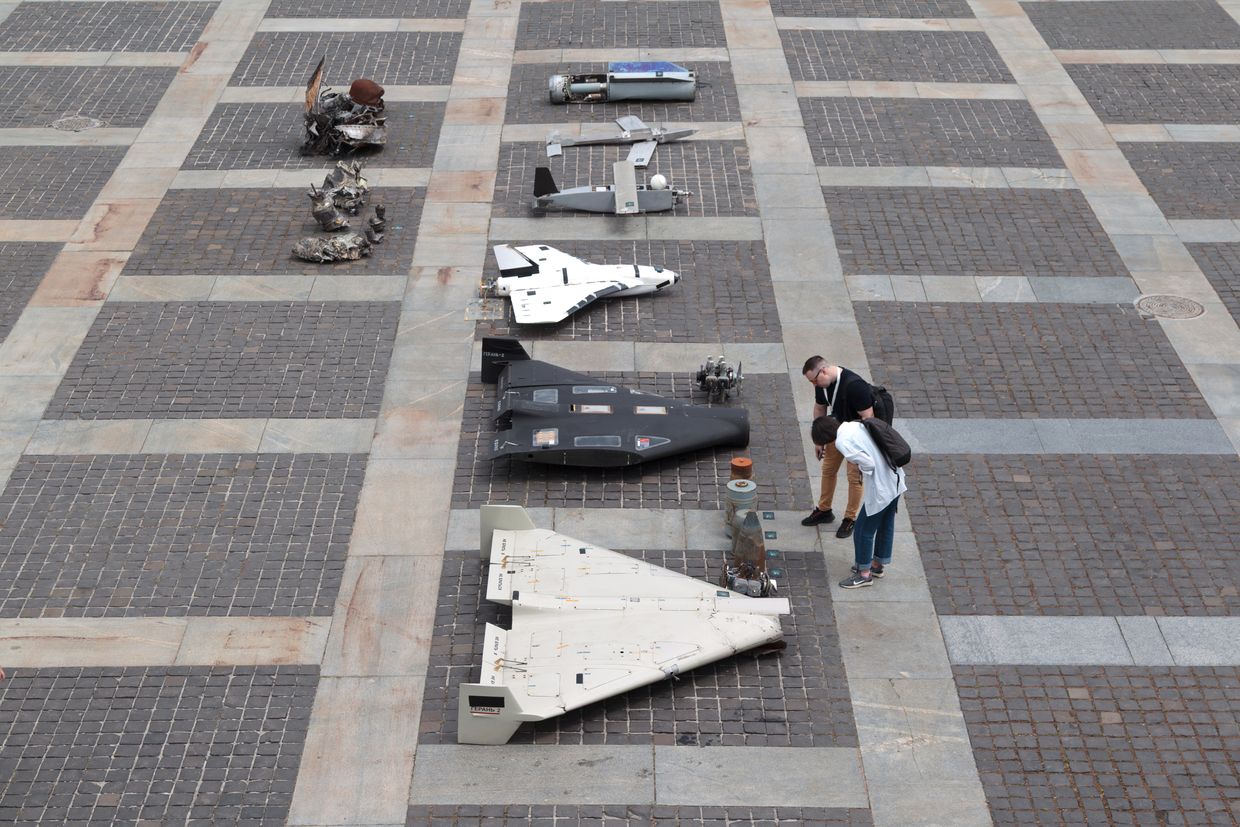
Russia’s growing ability to sustain weapons production despite Western sanctions is being driven by a flow of Chinese components and materials, Vladyslav Vlasiuk, the Ukrainian president’s commissioner for sanctions, told journalists on July 7.
Vlasiuk’s statement comes as Russia escalates its drone and missile strikes on Ukraine, while the U.S. continues to hold back on imposing tougher sanctions against Moscow and foreign-made components are still being found in Russian weapons used in the attacks.
Ukraine has previously documented that Chinese companies have contributed electronics and materials used in the production of these drones.
Just days earlier, after a large-scale Russian attack on July 4, Foreign Minister Andrii Sybiha shared on social media a photo of a component from a Shahed-136/Geran-2 combat drone discovered in Kyiv. According to Sybiha, the part was manufactured in China and delivered recently.
"The trend of China’s (role) is increasing," Vlasiuk told journalists.
He said that the presence of Chinese-made components and materials in Russian weapons is on the rise, adding that Beijing is expanding its technological capabilities and can now replicate some American technologies.
What an irony. Following tonight's massive Russian air attack on Ukraine, we discovered in Kyiv a component of a Russian-Iranian "Shahed-136"/"Geran-2" combat drone, which was made in China and supplied just recently.
— Andrii Sybiha 🇺🇦 (@andrii_sybiha) July 4, 2025
And right on the eve, the Chinese Consulate General's… pic.twitter.com/VetUqqVo67
When asked by Kyiv about the Chinese parts found in Russian weapons, Beijing responded by claiming that such support is "non-lethal," the president's commissioner for sanctions said.
Beijing remains one of Russia's key wartime partners, helping Moscow evade Western sanctions and emerging as the leading supplier of dual-use goods used by the Russian defense industry.
In April, President Volodymyr Zelensky said that China, alongside Iran and North Korea, is supplying weapons to Russia.
His remarks followed reports that Ukrainian soldiers had captured Chinese nationals fighting together with Russia's army in Donetsk Oblast. Later, Zelensky revealed that at least "several hundred" Chinese nationals are fighting on Russia's side in Ukraine.
Ukraine has already sanctioned several Chinese companies tied to Russia’s war effort.
The South China Morning Post reported that China's Foreign Minister Wang Yi reportedly told the EU's top diplomat Kaja Kallas on July 3 that the country cannot afford for Russia to lose the war in Ukraine amid fears Washington would shift focus towards Beijing.
 The Kyiv IndependentMartin Fornusek
The Kyiv IndependentMartin Fornusek